Revenge Class Battleship (1914)
Machinery
Boilers
Engines
Generators
Two 175 kw oil generators and two 200 kw steam generators, with an additional 200 kw steam generator from 1916 or later.[1]
Armament
Main Battery
This section is sourced by The Sight Manual, 1916.[2]
The eight 15-in guns were Mark I, able to elevate 20 degrees and depress 5 degrees.
The sights were cam-worked and capable of 20 degrees elevation in all but Royal Sovereign, which was like the Queen Elizabeth class in being limited to 15 degrees but with her central sights having "20 degree super-elevation strips".
The deflection gearing constant was 56.25 with 1 knot being 2.56 arc minutes. Range drums were graduated for 2400 fps for full charge and 2025 fps for 3/4 charge, as well as for 6-pdr sub-calibre and .303-in aiming rifle. There were no half-charge drums provided. MV was corrected by adjustable scale plate and deflection calibrated for 2450 fps at 5000 yards. Drift was allowed for by effectively inclining the periscope carrier 2.5 degrees. The central sighting scopes were 61 inches above and 46 inches aside the bore, and the side scopes were 43 inches above and 51.5 inches aside. There was also a temperature corrector fitted.
The trainer's sight could be made a free sight by releasing a clamp; the trainer then could vary the scope in pitch by shoulder supports. OOQ sights were fitted with settings for all but the .303-in aiming rifle.
Although the sights were FTP, the use of cams in the Range Master Transmitter indicates that the markings were not evenly spaced.[3]
6-in Guns
The fourteen 6-in guns were Mark XII on P IX mountings.[4] Deflection gearing constant was 53.7 and 1 knot equal to 2.68 arc minutes (2825 fps at 5000 yards). The range dials provided were full charge at 2750 fps, reduced charge at 2075 fps, 3-pdr sub-calibre, and 1-in and .303-in aiming rifles. Adjustable pointers permitted MV correction of +/- 150 fps. Drift correction was achieved by inclining the sight 1.75 degrees and by additionally setting 4 knots left deflection in reduced charge firings. The scopes were 19.5 inches above the bore.
The sights were cam-worked with equal-spaced range dials and FTP receivers; the eyepieces of the scopes coincided with the trunnion, reducing operator fatigue when tracking a target in roll. There was no "C" corrector fitted, but there were temperature and MV correctors.
Torpedoes
- Four Service Bar 21-in submerged broadside tubes depressed 2 degrees and bearing 90 degrees.[5]
Fire Control
There is an extensive set of diagrams and description of the fire control outfits of these ships in the Annual Report of the Torpedo School, 1915.
Rangefinders
The ships completed with 15-ft rangefinders in their GCTs and in all turrets and a 9-ft F.T. 24 on an M.Q. 10 mounting in the TCT.[6][7][8][9]
Sometime, likely not before 1918, the TCT RFs were to be upgraded to 15-foot instruments, probably also F.T. 24, with new armoured hoods and racers and training driving the hood directly rather than through the rangefinder mounting. These rangefinders lacked hand-following gear to facilitate in transmission of range cuts, and when it was considered as an addition around 1917, space concerns were causing issues.[10] Resolution received her 15-ft instrument in 1918.[11]
By 1918, two additional 9-foot instruments were also to be provided for torpedo control. On Ramillies, these were situated on each side of the lower searchlight bridge, requiring manipulating hut #1 to be resited forward and its roof lowered a bit. On the other ships, the RFs were placed on either side of the upper searchlight structure, inboard of #3 searchlight.[12]
Around 1918, the envisioned rangefinder outfit generally resembled this, but it would take some time to institute:[13]
- Two 30-ft in "B" and "X" turrets
- Two 15-ft in "A" and "Y" turrets
- Two 15-ft in TCT and GCT
- One 12-ft in spotting top
- Two 9-ft in fore bridge or platforms abreast funnels (probably the torpedo control ones)
- One 2m F.T. 29[14] high-angle RF on roof of control top
The move to upgrade some turret RFs to 30-ft models was achieved slowly, as was the addition of small rangefinders aft situated between searchlight towers for help in ranging on a consort astern to assist in accurate Concentration Firing.[15]
| Ship | 30-ft on "B" | 30-ft on "X" | small RF(s) aft |
|---|---|---|---|
| Revenge | 1918 | 1918 | 2 in 1919-21 |
| Royal Sovereign | Sep 1922 | 1919-21 | 1 in 1918 (removed Sep 1922) |
| Ramillies | 1918? 1919-21? | ||
| Royal Oak | 1919-21? June 1924? | 2 in 1919-21 | |
| Resolution | 1919-21 | 1 in 1919-21 |
Some RFs were removed from Resolution and Revenge in 1924.[16]
Phones
Main Battery
All phones for the main battery fire control was based on Pattern 333X Navyphones.[17]
The 15-in TS had an exchange board in communication with the ship's main navyphone exchange board. It had four exchange navyphones wired up to it, allowing them to converse with the following remote navyphones:
"Order" navyphones in:
- "A" turret
- "B" turret
- "X" turret
- "Y" turret
- GCT
- Spotting top
- "A" turret (fall of shot)
"Control" navyphones in:
- Gun control tower
- "X" turret
"Director fire" navyphones in:
- "X" turret
- Light aloft director tower
- Armoured director tower
"Range" navyphones in:
- Spotting top
- GCT
- "A" turret
- "B" turret
- "X" turret
- "Y" turret
In addition to the four general-use navyphones in the 15-in TS, the remote "range" navyphones in the turrets could also be directly addressed via four Pattern 3334 Navyphones wired into the TS's exchange board. A multiple plug permitted one of these to address all four turrets at once, if desired. Additionally, a navyphone in the conning tower was also connected to this exchange board.
Lastly, "X" turret's working space had a navyphone to the 15-in TS, working off a battery.[18]
Secondary Battery

Each 6-in gun control tower, port and starboard had a Pattern 3331 Navyphone wired directly to the 3 groups' COS on its side. In the 6-in TS, six Pattern 3332 Navyphones were wired directly to their own group COS, which each had 2 positions:
- 6-in GCT to all guns of its broadside
- TS group navyphone to its own group
The TS phones had switches which permitted one phone to pass orders to the whole broadside. Each officer of group had a Pattern 3333 Navyphone, and each gun was equipped with telaupads. Lastly, each 6-in gun director tower had a Pattern 3330 Navyphone wired directly to a Pattern 3332 Navyphone in the TS.[20]
Evershed Bearing Indicators

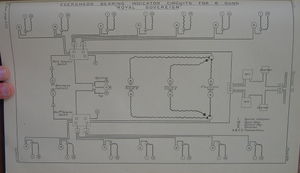
All five units were fitted with this equipment, at least for main and secondary batteries.
Mechanical Aid-to-Spotter
At some point, all ships in this class were equipped with four Mark II Mechanical Aids-to-Spotter:
- one on each side of the foretop, driven by flexible shafting from the Evershed rack on the director
- one on each side of the Gun Control Tower employing an electrical F.T.P. system.
As the need for such gear was apparently first identified in early 1916, it seems likely that these installations were effected well after Jutland.[23]
Gunnery Control
The control arrangements were almost certainly developed along lines similar to the King George V class, outlined here as follows.[Inference]
Control Positions
- Gunnery control tower
- "B" turret
- "X" turret
Control Groups
Main Battery
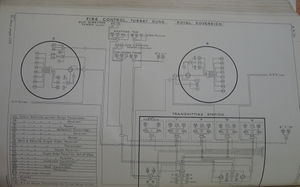
Notice the new "Fall of Shot" instruments, which seem to be a new development.
The four 15-in turrets were each a separate group with a local COS so that it could be connected to
- Transmitting Station
- Local control from officer's position within turret
Secondary Battery
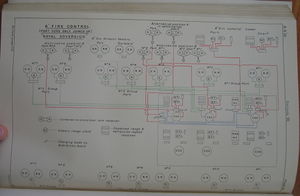
Notice the new "Fall of Shot" instruments, which seem to be a new development.
The secondary battery fire control was very similar to arrangements in Queen Elizabeth, but with fourteen rather than sixteen 6-in guns which were divided into 3 groups on each broadside:[26]
- 2 guns
- 3 guns
- 2 guns
The transmitting sources illustrated in the Annual Report of the Torpedo School, 1915 are quite lavish and indicate a strong belief in the value of the secondary battery.[27] Each of the 3 groups, port and starboard (6 in all), received its range, deflection and firing signals from one of 4 sources:
- from its own transmitter kit the TS (6 there, dedicated to group)
- a similar but not identical broadside transmitter kit located in the 6-in gun control tower (2 there, dedicated to broadside)
- a Spartan alternative control position "A" in the spotting top (2 there, dedicated to broadside)
- a Spartan alternative control position "B" elsewhere (6 there, dedicated to group)
Each of the 6 groups had a 4-way COS in the TS to determine which source would inform the guns of its group.
The COSes each had a combined range and deflection receiver monitoring its output indications for use as a tally and also as a repeat to the use of the group's transmitter in the TS. Those 6 group transmitting kits were capable of generating range, deflection and firing signals. The range and deflection were entered by hand crank, and the operator used the combined tally device to know what value was going out.
The 2 broadside transmitter kits in the 6-in GCT were the most elaborate, as they each had a Vickers range clock to supply its range data. Otherwise, they were similar to the group kits in the TS below.
Alternative control position "A" had 2 small transmitting kits, one for each broadside. These were more Spartan than the main ones as they had no range clock and substituted a range transmitter and a deflection transmitter, each with an integral repeat. The outputs fed all 6 group COSes in the TS.
Alternative position "B" was more extensively furnished as it had 6 of these Spartan kits, one for each group. The output of each was fed directly to the COS for its group in the 6-in TS below. .[28]
A fall-of-shot transmitter in the spotting top worked receivers in each 6-in gun control tower.[29]
Directors
Main Battery

These details probably varied little in other capital ships with directors.[Inference]

These details probably varied little in other capital ships with directors.[Inference] The COS in the TS is the same as that shown in the previous figure of firing circuits.
These ships were completed with two cam-type tripod-mounted directors, one in an armoured tower and one in a light aloft tower,[32] as well as a directing gun in the "X" turret.[33]
The battery's fire could be divided into fore ("A" & "B") and aft ("X" & "Y") groups, with a C.O.S. in the TS affording these options:[34][35]
- all on aloft director
- all on armoured director
- all on directing gun
- forward group on aloft director, aft group on armoured director
- forward group on armoured director, aft group on directing gun
The main and auxiliary firing circuits had paired pistols in all 3 director positions, and were wired through the same COS as the training and elevating circuits. In the turret's firing circuits fed a "trainer's switch", which could be "on" or "off", and then to a 3-way COS at each gun to select which director firing circuit was tied to which gun firing circuit:
- main on main, aux on aux
- main on aux, aux on main (crossover)
- local firing circuits
Sometime in 1916 or thereafter, it was likely that the directors in these ships were augmented by the addition of Henderson Firing Gear.[37]
Secondary Battery

This is for the similar Queen Elizabeth class — note more pertinent images below for possible differences.
The 6-in broadside guns were supported by a pair of pedestal-mounted directors, installed in March and April 1917, except in in Ramillies (June 1918).[39] These were situated to port and starboard on her forward superstructure. There were no options to use a director other than the one on the given broadside. The firing circuits were similarly straightforward, with each gun and director having a COS offering probably the same options as for the main battery guns:[40][41][42] [Inference]
- main on main, aux on aux
- main on aux, aux on main (crossover)
- local firing circuits
Queen Elizabeth's systems were noted as being quite similar.[43]
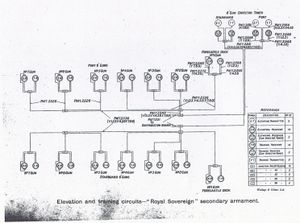

Transmitting Stations
There were separate TSes for 15-in and 6-in batteries.[46]
The 6-in TS's arrangement is illustrated in the control section above.
Dreyer Table
These ships each had a Mark IV* Dreyer Table (though it is possible Ramillies had a Dreyer Table Mark V),[47]. At some point, the ships each received Dreyer Turret Control Tables, but it is unclear when and whether each turret received one or simply the two control position turrets.[48]
Fire Control Instruments
It is likely that the ships continued the pattern first established in the Colossus class, all 5 units used Vickers F.T.P. Mark III range and deflection instruments to the gun sights and Barr and Stroud (probably Mark II*[Inference]) instruments for other purposes.[49]
The ships had Gun Ready signals in the TS and control positions, but had no Target Visible signals.[50]
In 1916, it was approved that the ships should have a range rate transmitter/receiver pair between TS and spotting top for the main armament. Additionally, it was ordered that Lion and King George V classes and later should receive instruments such that the fore top could be interchangeable as a gun control position with the GCT.[51]
The ships had a pair of Dumaresq Mark VII*s, one on each side, with bearing transmitters and handles to work them. These were the sources of the relative bearings sent below to the Dreyer table in the TS. Beneath these were situated Repeaters, which indicated the inclination, enemy course, enemy speed and range rate in use in the TS.[52]
Torpedo Control
As the diagram in ARTS 1915 makes clear, control could be exercised from either the aft torpedo control tower or the conning tower, and each tube had a set of instruments for communicating with each, obviating the need for a change-over switch.
In 1916, arrangements were to be made that all capital ships with 21-in torpedoes were to receive transmitters and receivers so that the TCT could pass the plotted torpedo deflection to the CT, which could then use a reciprocal set of equipment to send the TCT a deflection to be placed on the sight and range to open fire.[53]
By mid 1917, if not at completion, the ships were fitted with a Torpedo Control Plotting Instrument Mark II in the TCT.[54]
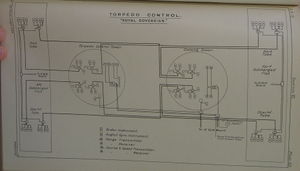
Notice the duplicate instruments at each tube, one to each control position. Course and speed information could be supplied from the 15-in TS, and the GCT's rangefinder was wired to provide range data.
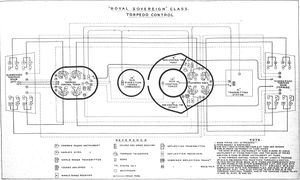
Phones
The phones were generally Pattern 333X Navyphones, except that Pattern 2465 special transmitters wired in parallel to the navyphones were used from either torpedo control position when addressing tubes at the opposite end of the ship.[57]
In the torpedo control tower:
- Four Pattern 3331 Navyphones, one addressing each tube
- Two Pattern 2465 special transmitters wired in parallel to the 3331s addressing the forward tubes
- One 3331 to the 15-in TS
- One 3331 to the GCT
- One 3331 to the CT (the forward torpedo control position)
In the conning tower:
- Two Pattern 3331 Navyphones, one addressing each after tube
- Two Pattern 2465 special transmitters wired in parallel to the 3331's addressing the after tubes
- One 3331 to the 15-in TS
- One 3331 to the TCT (the after torpedo control position)
I infer from the lack of navyphones in the conning tower to reach the forward torpedo tubes that these might have enjoyed voicepipe connectivity.[Inference]
Alterations
In 1916, it was approved that an additional 200 kw steam dynamo be added to the Revenge, Queen Elizabeth, Renown and (possibly) Courageous and Furious classes, as the loss of any of the other four sets could impose an undue burden on the remaining generators, especially in a night action. Prior to the addition, the Revenge class could generate 750 kw, or 3,300 amperes.[58]
See Also
Footnotes
- ↑ Annual Report of the Torpedo School, 1916, pp. 120-121.
- ↑ The Sight Manual, 1916, pp. 20-22, 109.
- ↑ Captain F. C. Dreyer's Fire Control Apparatus, Mark IV, Sheet 23.
- ↑ The Sight Manual, 1916, pp. 61-2.
- ↑ Annual Report of the Torpedo School, 1915, p. 36.
- ↑ Burt. British Battleships, drawing pp. 274-5.
- ↑ Annual Report of the Torpedo School, 1917, p. 198.
- ↑ Annual Report of the Torpedo School, 1918, p. 175.
- ↑ Inferences M.Q. 10 and F.T. 24
- ↑ Annual Report of the Torpedo School, 1917, p. 198. (C.I.O. 481/17)
- ↑ Burt. British Battleships, p. 282.
- ↑ Annual Report of the Torpedo School, 1918, p. 177.
- ↑ Burt. British Battleships, pp. 276-7, 282.
- ↑ length and type inferred from reported 6-ft 6-in base length and knowledge of B&S RFs.
- ↑ Burt. British Battleships, p. 282. The source is confusing on the 30-ft RFs!
- ↑ Burt. British Battleships, p. 282. The type is not mentioned.
- ↑ Annual Report of the Torpedo School, 1915, p. 230.
- ↑ Annual Report of the Torpedo School, 1915, p. 231.
- ↑ Annual Report of the Torpedo School, 1915. Plate 115.
- ↑ Annual Report of the Torpedo School, 1915, p. 231.
- ↑ Annual Report of the Torpedo School, 1915. Plate 120.
- ↑ Annual Report of the Torpedo School, 1915. Plate 119.
- ↑ The Technical History and Index: Fire Control in HM Ships, 1919, pp. 25-6.
- ↑ Annual Report of the Torpedo School, 1915. Plate 112.
- ↑ Annual Report of the Torpedo School, 1915. Plate 114.
- ↑ Annual Report of the Torpedo School, 1915, p. 231.
- ↑ Annual Report of the Torpedo School, 1915, Plate 114.
- ↑ Annual Report of the Torpedo School, 1915, Plate 114.
- ↑ Annual Report of the Torpedo School, 1915, p. 231.
- ↑ Annual Report of the Torpedo School, 1915. Plate 116.
- ↑ Annual Report of the Torpedo School, 1915. Plate 117.
- ↑ The Director Firing Handbook, 1917. p. 142.
- ↑ The Director Firing Handbook, 1917. pp. 88, 142.
- ↑ The Director Firing Handbook, 1917. pp. 88-9.
- ↑ Annual Report of the Torpedo School, 1915, p. 232.
- ↑ Annual Report of the Torpedo School, 1916, Plate 87.
- ↑ Annual Report of the Torpedo School, 1916, p. 152.
- ↑ Annual Report of the Torpedo School, 1915, Plate 118.
- ↑ The Technical History and Index, Vol. 3, Part 23. 191, p. 16.
- ↑ The Director Firing Handbook, 1917. p. 143.
- ↑ The Director Firing Handbook, 1917. Plate 79.
- ↑ The Director Firing Handbook, 1917. Plate 80.
- ↑ Annual Report of the Torpedo School, 1915, p. 232.
- ↑ The Director Firing Handbook, 1917. Plate 79.
- ↑ The Director Firing Handbook, 1917. Plate 80.
- ↑ Annual Report of the Torpedo School, 1915, pp. 230-1.
- ↑ Handbook of Capt. F.C. Dreyer's Fire Control Tables, p. 3.
- ↑ Handbook of Capt. F.C. Dreyer's Fire Control Tables, p. 3.
- ↑ Handbook for Fire Control Instruments, 1914, pp. 72.
- ↑ Handbook for Fire Control Instruments, 1914, p. 11.
- ↑ Handbook for Fire Control Instruments, 1916, p. 145.
- ↑ Captain F. C. Dreyer's Fire Control Apparatus, Mark IV, Sheet 19A.
- ↑ Annual Report of the Torpedo School, 1916, p. 145.
- ↑ Handbook of Torpedo Control, 1916, p. 38.
- ↑ Annual Report of the Torpedo School, 1915, Plate 113.
- ↑ Handbook of Torpedo Control, 1916, Plate 28.
- ↑ Annual Report of the Torpedo School, 1915, p. 230.
- ↑ Annual Report of the Torpedo School, 1916, pp. 120-121.
Bibliography
- Template:BibUKFireControlInHMShips1919
- Admiralty, Gunnery Branch (1914). Handbook for Fire Control Instruments, 1914. G. 01627/14. C.B. 1030. Copy 1235 at The National Archives. ADM 186/191.
- Template:BibUKFireControlInHMShips1919
- Template:BibUKDirectorFiringHandbook1917
- Template:BibUKDreyerTableHandbook1918
- Template:BibUKARTS1915
- Template:BibBritishBattleshipsofWorldWarTwo
